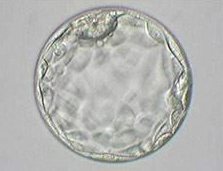Involuntary childlessness today is no longer an inevitable fate, thanks to a wide range of treatment methods. This variety includes different approaches in terms of their efficiency which, from the perspective of the respective physicians, biologists and experts, undoubtedly also play a role here. However, from a scientific point of view, it is important to take a very critical look at them. This also applies to one of the most essential points with respect to IVF treatment, namely assessing the development potential of growing embryos.
Due to our competence that is based on over three decades of experience in successfully performing assisted reproductive techniques, we are able to identify efficient methods and, more than anything, to safely use these methods. Since 1996, we have established at our IVF Center in Bregenz an IVF technique known as blastocyst culture (extended culture up to the 5th day of embryonic development) as the method of choice in order to improve pregnancy rates (first systematic blastocyst culture worldwide).
For many years it has been argued that an analysis involving the parameters below, enable the same results to be obtained as when performing blastocyst culture.
- Careful PN-scoring (quality assessment of pronuclear stage oocytes) on the basis of certain pre-defined criteria may enable the further development to be predicted (Montag et al., 2011; Wharf et al.,2004; Gianaroli et al., 2003; Montag et al., 2001; Tesarik und Greco, 1999).
- An assessment of oocyte morphology would allow further conclusions to be drawn regarding the embryo’s potential for development and implantation (Montag und van der Ven, 2008; Otsuki et al., 2004).
- Selection on the basis of cell division velocity on day 1 of embryonic development, combined with the above mentioned prognostic markers, would allow for significantly higher pregnancy rates (Van Montfoort et al., 2004).
So why would we want to perform blastocyst culture?
Today, however, these examples from medical literature do not quite stand up to scientific criteria. This is due among other things to the fact that the activation of the embryonic genome occurs about three days after fertilization. This means that based on today’s state of science, blastocyst culture including embryo transfer on day 5 can be considered an appropriate method to assess the embryo’s potential for implantation.
The prerequisite, however, is the mastery of blastocyst culture (the legal framework conditions for blastocyst selection vary from one country to another).
The advantages of blastocyst culture including transfer on day 5 compared to embryo transfer on day 2/3 have been proven by some scientifically sound publications:
- Blake, DA., Farquhar, CM., Johnson, N., Proctor, M., 2007. Cleavage stage versus blastocyst stage embryo transfer in assisted conception. Cochrane Database Syst. Rev. CD002118.
- Glujovsky, D., Blake, D., Farquhar, C., Bardach, A., 2012. Cleavage stage versus blastocyst stage embryo transfer in assisted reproductive technology. Cochrane Database Syst Rev. 11, 7:CD002118. doi: 10.1002/14651858
- Zech, NH., Lejeune, B., Puissant, F., Vanderzwalmen, S., Zech, H., Vanderzwalmen, P., 2007. Prospective evaluation of the optimal time for selecting a single embryo for transfer: day 3 versus day 5. Fertil. Steril. 88, 244–246.
Blastocyst culture and success prognosis
In addition to the correct application of treatment methods that are individually tailored to the couple’s needs, a number of factors contribute towards achieving a successful pregnancy. In order to let them know what their situation is in terms of the probability of a pregnancy, we have developed and established a new standard at our IVF centers – named EGP-Expected Gametes Performance (Expected Development Potential of female and male gametes).
With regard to the treatment sequence, EGP enables us to focus on developing blastocysts by concentrating not only on lab parameters, ultrasound scans and the number of retrieved eggs, but also considering the stimulation protocol, IMSI results, the embryo culture technique, the freezing technique etc. These parameters are combined in the EGP, thus allowing far more accurate prognostic assessment with respect to the chances of success.
To simplify the access to the treatment
As already demonstrated by the EGP, we are determined to individually address the needs of our patients and to offer comprehensive counseling. This of course also includes individual advice on a treatment involving blastocyst culture as well as on costs and possible reimbursement by health insurance funds. Infertile couples from Germany, for instance, who seek treatment in other EU Member States, have the opportunity to apply for a payment by the health insurance in the same amount as a treatment in Germany (in combination with applicable laws on “artificial insemination”).
Experience and quality prevail
In summary, we can say that numerous critics have in the meantime confirmed the benefits of blastocyst culture. As with many other new developments, it has been shown here once again that the pursuit of quality in treatment as well as in technology and science asserts itself in the long term. We intend to fulfill each couple’s desire to have a healthy child – and this “if possible as early as the first treatment cycle!”
← Home
→ Contact
















